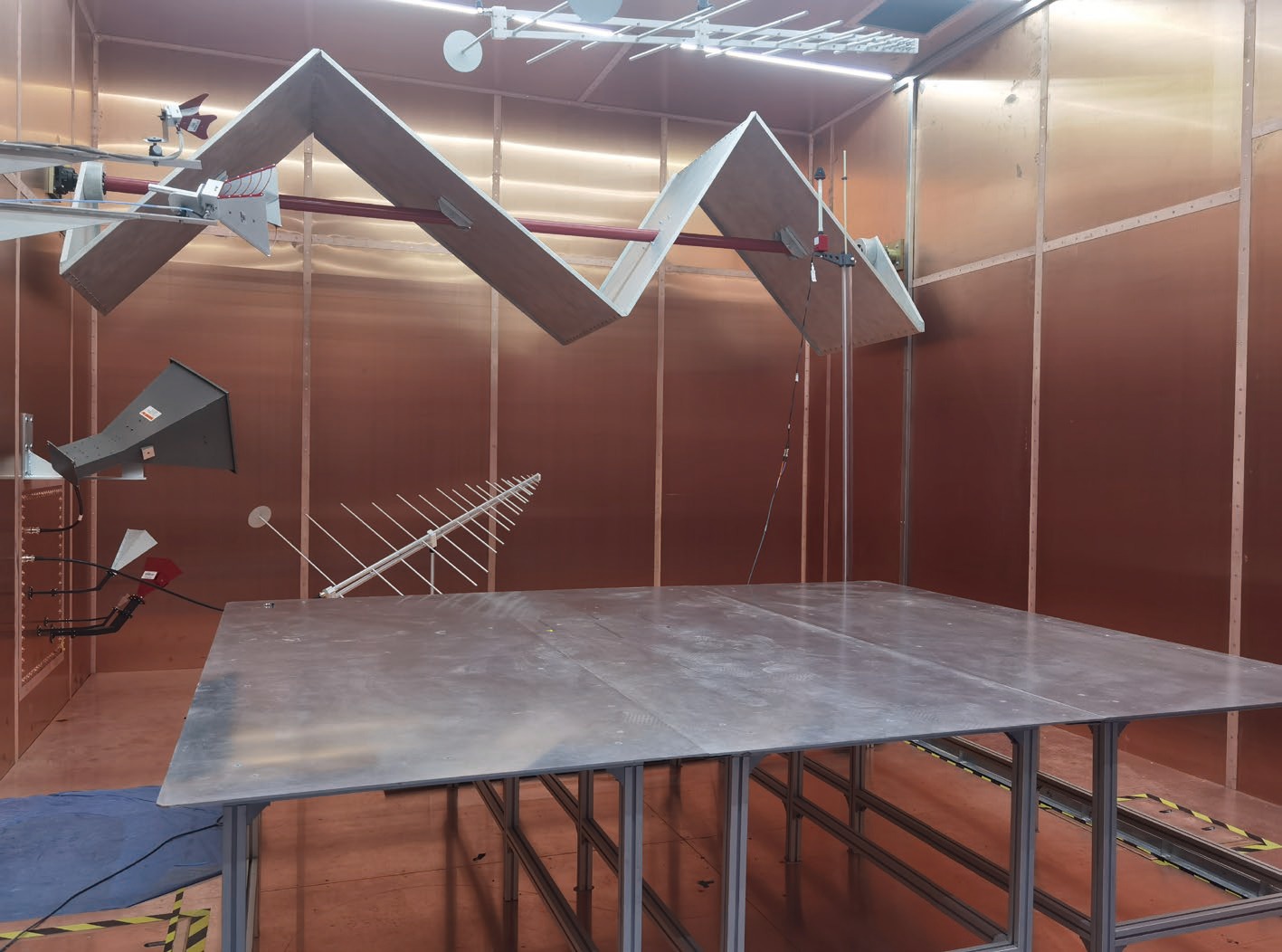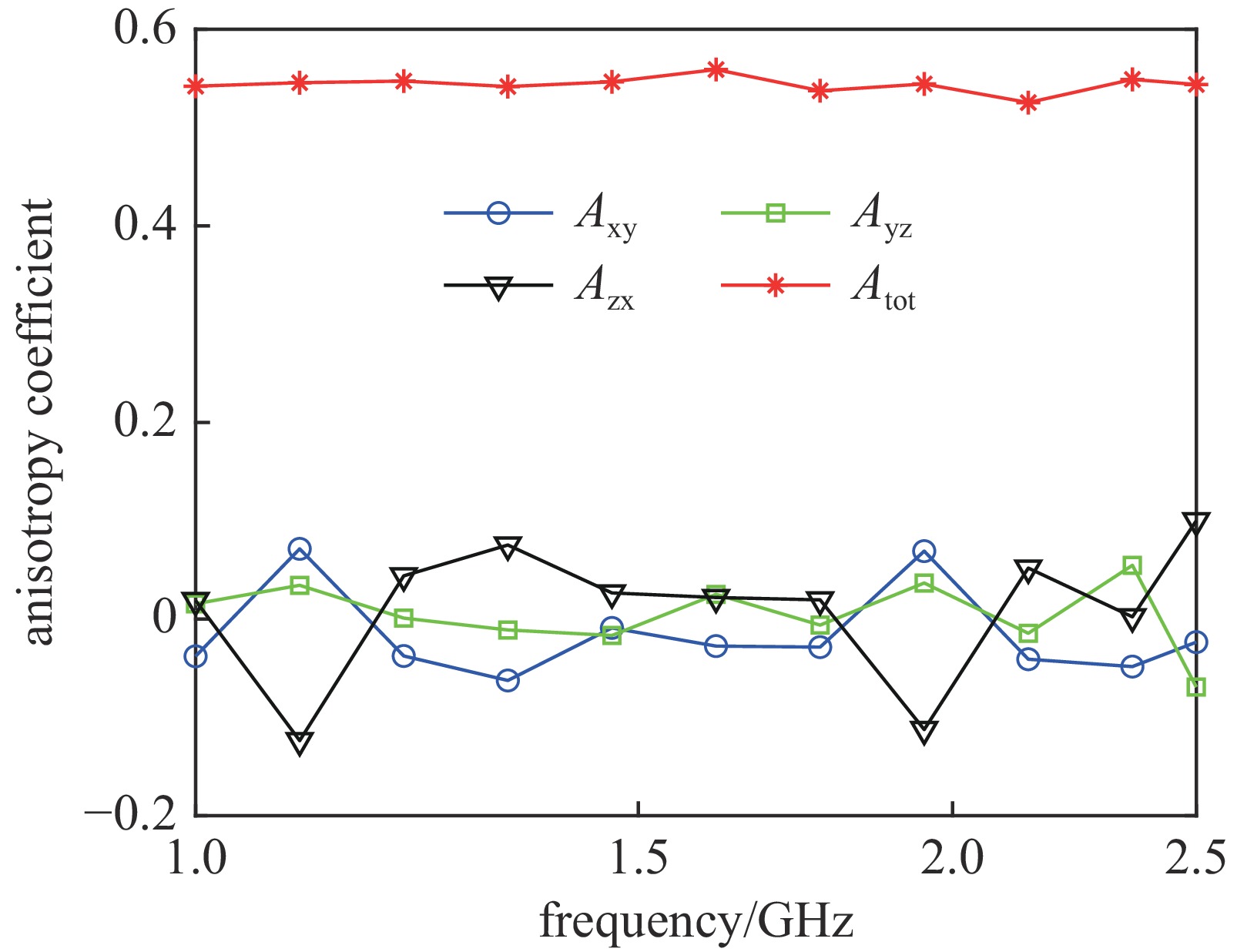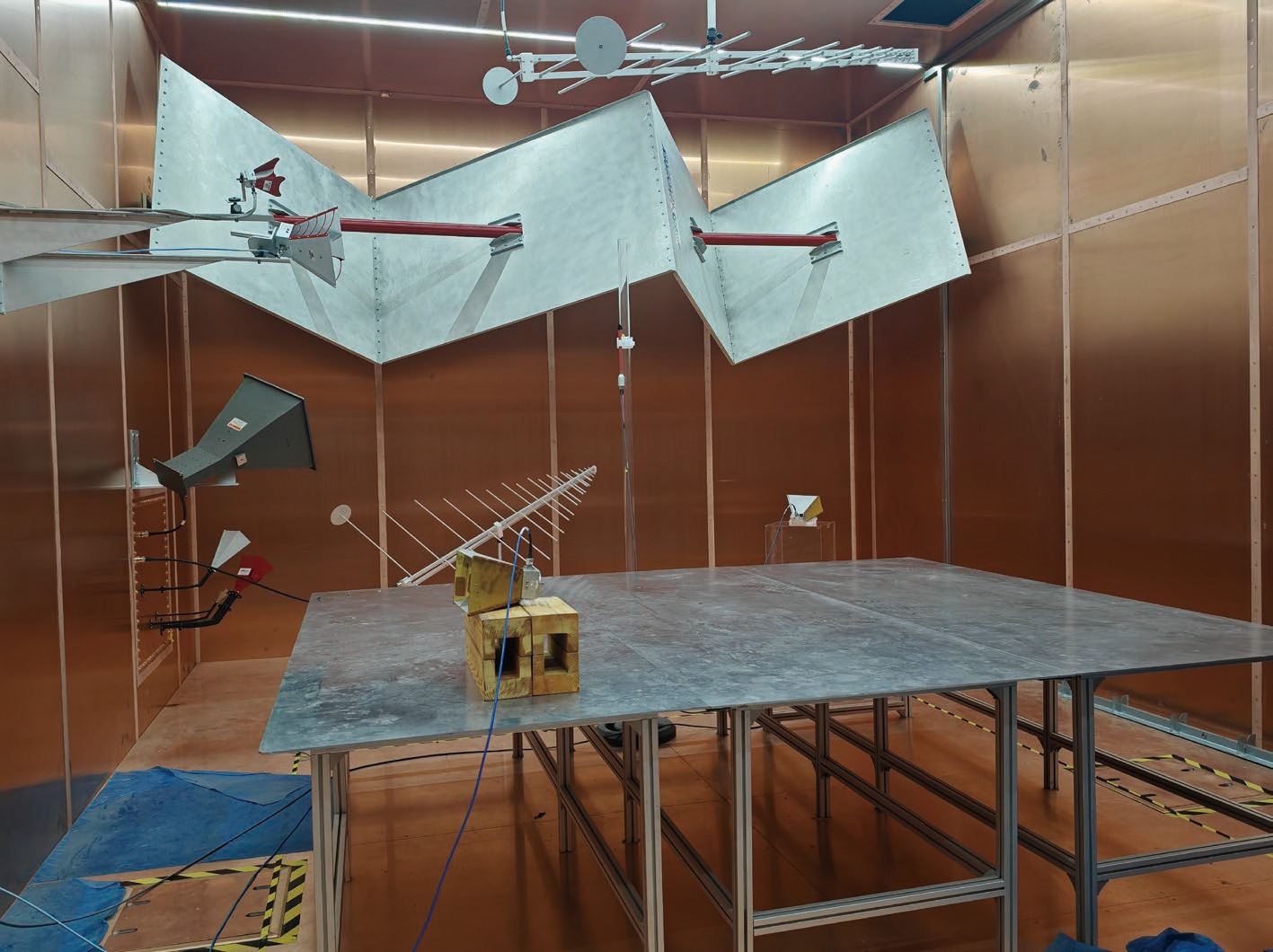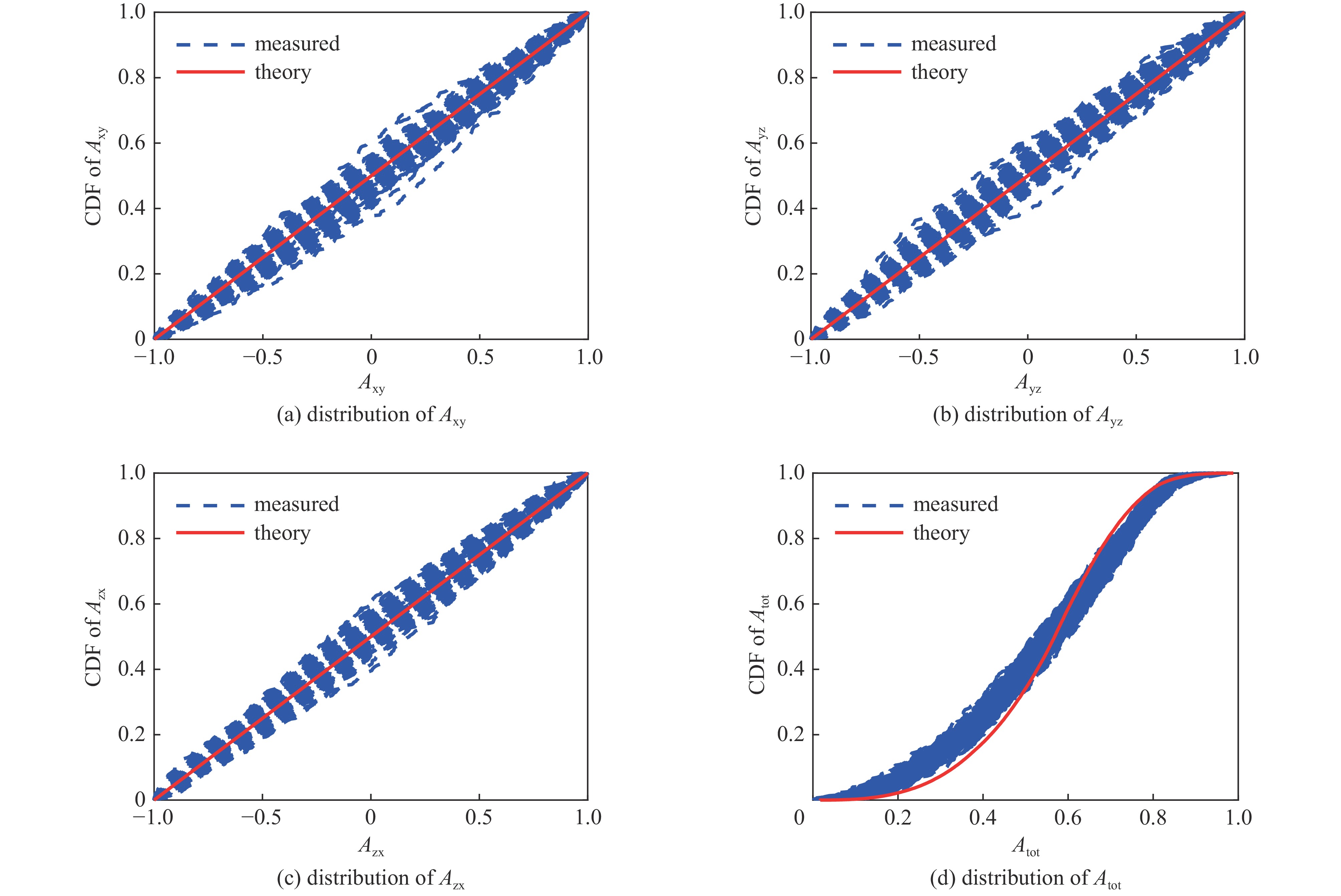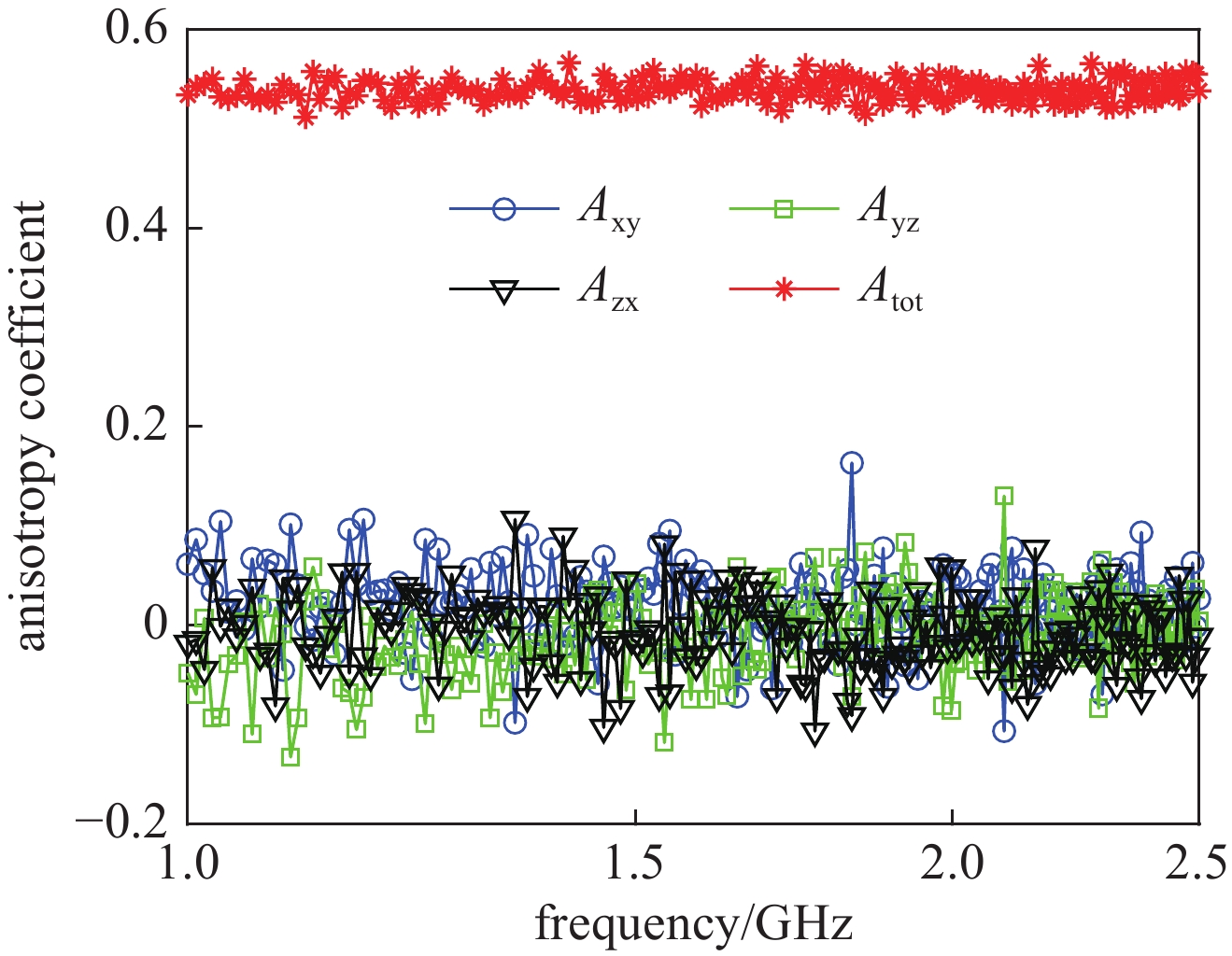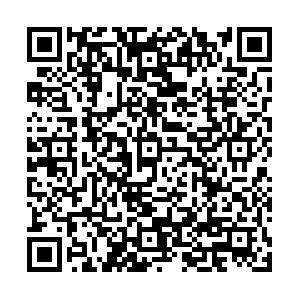Evaluation of field anisotropy coefficient in reverberation chamber and research on its optimal measurement method
-
摘要: 混响室的场各向异性系数定量评估了混响室性能且可用于混响室间的比较,对于混响室性能评估具有重要作用。首先对混响室场各向异性系数理论分布情况进行了介绍,明确理想情况下二维场各向异性系数应为0,三维场各向异性系数应为
0.5547 ;然后基于三维电场探头按标准对混响室场各向异性系数进行了评估,各频点二维场各向异性系数处于[−0.1, 0.1]之间,三维场各向异性系数处于[0.5254 ,0.5589 ]之间,整体小于−15 dB,按标准该混响室具有“良好的”性能;最后针对测试流程繁复的问题提出了基于混响室散射参数的场各向异性系数优化测试方法,所需测试次数成倍减少,试验结果显示除个别频点外整体场各向异性系数小于−15 dB,与原方法基本相同,为混响室性能评估提供了重要工程实践指导经验。Abstract:Background The reverberation chamber (RC) is widely used for electromagnetic compatibility testing. The field anisotropy coefficient is a key parameter for quantitatively evaluating its performance and enabling comparisons between different chambers, playing a critical role in assessing RC quality.Purpose This study aims to evaluate the field anisotropy coefficient of a reverberation chamber according to standard methods, verify its performance level, and propose an optimized testing approach to reduce the complexity and time required for measurement while maintaining accuracy.Methods First, the theoretical distribution of the field anisotropy coefficient was reviewed, indicating ideal values of 0 for 2D and0.5547 for 3D. Measurements were then carried out using a three-axis electric field probe following standard procedures. To streamline the process, an optimized method based on scattering parameters was introduced, significantly reducing the number of required measurements.Results The standard measurement results showed that the 2D field anisotropy coefficient fell within [−0.1, 0.1], and the 3D coefficient was between [0.5254 ,0.5589 ]. Overall, the values were below −15 dB, indicating “good” performance of the chamber according to the standard. The proposed optimized method produced consistent results, with field anisotropy coefficients largely remaining below −15 dB except for a few frequency points.Conclusions The reverberation chamber under test demonstrates good performance. The proposed scattering parameter-based method greatly reduces test time and complexity while yielding results consistent with those of the standard approach. This offers valuable practical guidance for efficient and accurate reverberation chamber evaluation. -
表 1 测试结果
Table 1. Results of experiments
$ \left\langle {A_{xy}} \right\rangle $ $ \left\langle {A_{y{\textit{z}}}} \right\rangle $ $ \left\langle {A_{{\textit{z}}x}} \right\rangle $ $ \left\langle {A_{{\rm{tot}}}} \right\rangle $ max 0.0715 (−11.46 dB)0.0547 (−12.62 dB)0.1000 (−10.00 dB)0.5589 (−23.77 dB)min − 0.0624 (−12.05 dB)−0.069 (−11.61 dB) − 0.1236 (−9.08 dB)0.5254 (−15.33 dB)表 2 测试结果
Table 2. Results of experiments
$\left\langle {A_{xy}} \right\rangle $ $\left\langle {A_{y{\textit{z}}}} \right\rangle $ $\left\langle {A_{{\textit{z}}x}} \right\rangle $ $\left\langle {A_{{\rm{tot}}}} \right\rangle $ max 0.1636 (−7.86dB)0.1302 (−8.85dB)0.1067 (−9.72dB)0.5666 (−19.24dB)min − 0.1065 (−9.73dB)− 0.1326 (−8.77dB)− 0.1065 (−9.73dB)0.5116 (−13.66dB) -
[1] 潘晓东, 魏光辉, 万浩江, 等. 电子设备电磁辐射敏感度测试相关问题研究[J]. 强激光与粒子束, 2020, 32: 073002 doi: 10.11884/HPLPB202032.200088Pan Xiaodong, Wei Guanghui, Wan Haojiang, et al. Research on several test issues of electromagnetic radiation susceptibility for electronic equipment[J]. High Power Laser and Particle Beams, 2020, 32: 073002 doi: 10.11884/HPLPB202032.200088 [2] GJB 8848-2016, 系统电磁环境效应试验方法[S]GJB 8848-2016, Electromagnetic environmental effects test methods for systems[S] [3] GJB 9257-2017, 高功率微波效应试验方法 窄带高功率微波辐照法[S]GJB 9257-2017, Test method for high power microwave effects—narrow band high power microwave radiation method[S] [4] GJB 9896-2020, 高功率微波效应试验方法 超宽带高功率微波辐照法[S]GJB 9896-2020, Test method for high power microwave effects—ultra-wide band high power microwave radiation method[S] [5] GJB 151B-2013, 军用设备和分系统电磁发射和敏感度要求与测量[S]GJB 151B-2013, Electromagnetic emission and susceptibility requirements and measurements for military equipment and subsystems[S] [6] Sorrentino A, Nunziata F, Cappa S, et al. A semi-reverberation chamber configuration to emulate second-order descriptors of real-life indoor wireless propagation channels[J]. IEEE Transactions on Electromagnetic Compatibility, 2021, 63(1): 3-10. doi: 10.1109/TEMC.2020.3005770 [7] Hu Dezhou, Wei Guanghui, Pan Xiaodong, et al. Investigation of the radiation immunity testing method in reverberation chambers[J]. IEEE Transactions on Electromagnetic Compatibility, 2017, 59(6): 1791-1797. doi: 10.1109/TEMC.2017.2698141 [8] GB/T 17626.21-2014, 电磁兼容 试验和测量技术 混波室试验方法[S]GB/T 17626.21-2014, Electromagnetic compatibility—testing and measurement techniques—reverberation chamber test methods[S] [9] 周香. 混波室设计及其在电磁兼容测试中的应用[D]. 南京: 东南大学, 2005: 66Zhou Xiang. The design of reverberation chamber and the application in EMC test[D]. Nanjing: Southeast University, 2005: 66 [10] 张华彬, 赵翔, 周海京, 等. 混响室的概率统计分析方法及其蒙特卡罗模拟[J]. 强激光与粒子束, 2011, 23(9): 2475-2480 doi: 10.3788/HPLPB20112309.2475Zhang Huabin, Zhao Xiang, Zhou Haijing, et al. Probabilistic and statistical analysis of mode stirred reverberation chamber and its Monte Carlo simulation[J]. High Power Laser and Particle Beams, 2011, 23(9): 2475-2480 doi: 10.3788/HPLPB20112309.2475 [11] Andrieu G, Ticaud N, Lescoat F, et al. Fast and accurate assessment of the “Well Stirred Condition” of a reverberation chamber from S11 measurements[J]. IEEE Transactions on Electromagnetic Compatibility, 2019, 61(4): 974-982. doi: 10.1109/TEMC.2018.2847727 [12] Yousaf J, Ghazal M, Hasan M N, et al. Rapid alternative calibration procedure of reverberation chamber using coupling transfer gain function[C]//Proceedings of the 2020 IEEE International Symposium on Antennas and Propagation and North American Radio Science Meeting. 2020: 1273-1274. [13] Yousaf J, Ghazal M, Lee H, et al. Efficient assessment of well-stirred operation of reverberation chamber using coupling transfer gain functions[J]. Journal of Electromagnetic Waves and Applications, 2021, 35(3): 315-335. doi: 10.1080/09205071.2020.1837682 [14] 胡鹏. 搅拌模式混波室敏感度测试技术研究[D]. 南京: 东南大学, 2021Hu Peng. Study on radiated susceptibility tests using mode-stirred reverberation chamber[D]. Nanjing: Southeast University, 2021 [15] 李金朋. 电火工品强射频场防护关键技术研究[D]. 南京: 东南大学, 2020Li Jinpeng. Research on the key technology of high intensity RF field protection for the electric-explosive device[D]. Nanjing: Southeast University, 2020 -





 下载:
下载:
